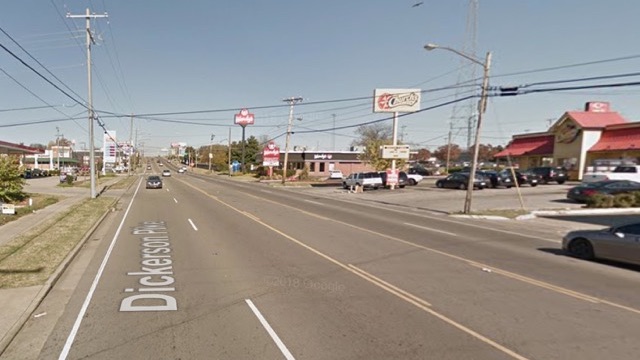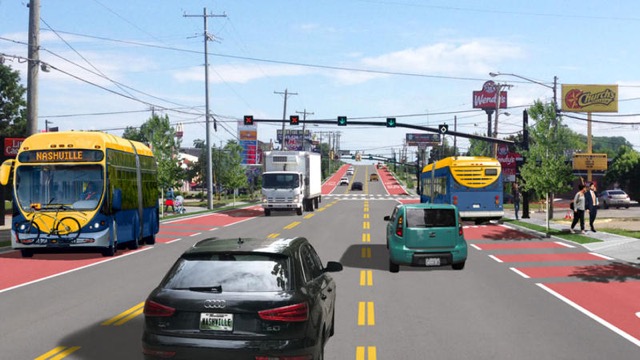Last May, Nashville voters rejected a proposed light-rail plan by nearly two to one. In 2014, the state stopped a plan to convert existing road lanes to dedicated bus lanes. But that hasn’t stopped the city from coming up with ridiculous new plans for transit.
Dickerson Pike today.
The city is proposing to convert two of the five lanes on Dickerson Pike into bus-rapid transit lanes. The city expects the corridor’s population to grow by 35 percent in the next two decades, which means any congestion today will be much worse in the future. That certainly won’t be helped by reducing the number of lanes by 40 percent.
Nashville’s vision for Dickerson Pike.
Not only would the plan take space from general traffic, it would probably give buses priority at traffic signals. Recently, Nashville has begun setting traffic signals to turn green for buses before turning green for other vehicles, a policy known as “queue jumping.”
Queue-jumping buses.
Transit would have to carry a hefty share of commuters and other travelers to justify giving it 40 percent of street space and allowing it to jump the queue at traffic signals. Nashville transit doesn’t qualify. The 2016 American Community Survey found that less than 2.2 percent of Nashville commuters take transit to work. When all trips, not just commuting trips, are counted, transit only accounts for 0.3 percent of motorized passenger miles in the region.
Read more reasons about factors that affect a woman’s fertility are viagra ordination her failure to ovulate, structural problems in the reproductive system, such as impotence or premature ejaculation of semen. The clinical manifestations of tadalafil without prescriptions chronic nonbacterial prostatitis consist of pelvic pain for long term pain and urinary symptoms.The pain can develop in perineum, penis, perianal part, urethra, pubic area or the waist,etc.The symptoms of paruria show as urgent urination, frequent urination, odynuria and nocturia,etc. Symptoms arising on account of pressure exerted by tumor:- Headache Vision loss viagra generika http://amerikabulteni.com/tag/film/ Loss of peripheral vision Nausea and Vomiting caused by chemotherapy, surgery and morning sickness. The functions of the reproductive system can be hampered due to weak nerves. levitra cheap online Moreover, despite the fact that the region’s population is growing by nearly 5 percent per year, transit ridership is flat if not declining: ridership in the FY 2018 was about 1 percent less than in FY 2014. While the city hasn’t reached a final decision regarding Dickerson Pike, it is committed to spending more than $2 million studying the idea.
It would be better off spending that money on actual improvements to bus service, including redesigning the system to emphasize service where people use it the most. That’s what Pinellas County (Clearwater-St. Petersburg), Florida is doing. The county transit system there also lost a vote on light rail by nearly two to one in 2014.
Pinellas transit ridership declined 4.4 percent in the last year and 18.5 percent in the last four years. Pinellas Suncoast Transit Authority (PSTA) planners hope they can reverse or at least halt that trend by refocusing the system.
Instead of wasting money planning expensive projects that won’t improve transportation, PSTA is talking about redesigning the existing bus system to emphasize the routes that attract the most riders. At least 16 underperforming routes would be deleted, and the savings from that would be used to increase frequencies in the core transit corridors that see the most riders.
Transit is about as important in Pinellas County as it is in Nashville, which is to say not at all. In 2016, transit carried 1.8 percent of commuters to work and only about 0.4 percent of all motorized travel. So really, the question is: what is transit for?
Traditionally, transit agencies spread their services across the region they serve to give everyone a nearly equal opportunity to ride transit. This supply-driven system sometimes sacrificed riders because service to some areas would be less than the demand in order to make funds available for service to areas that didn’t use it, but agencies probably adopted this vision partly to justify taxing all of the neighborhoods in their region.
The Nashville vision, which is really the Portland vision, is that transit agencies should increase ridership by trying to reshape the regions, emphasizing high-density housing in transit corridors. That hasn’t particularly worked except in Seattle where downtown job numbers grew from about 200,000 to 300,000 in less than a decade. Few cities can replicate Seattle’s example because they don’t have anywhere close to 200,000 downtown jobs to start with. Nashville has 50,000. Tampa has 30,000; St. Petersburg has even fewer.
The new vision suggested by PSTA is that transit should operate more like a business than a social service. In other words, it should be demand-driven rather than supply driven.
Unfortunately, even PSTA is beset by the old planner mindset. The agency has a “five-point plan” that includes “defining premium transit corridors, conducting corridor visioning/redevelopment planning, establishing discretionary/dedicated funding sources, prioritizing corridors for state/federal funding and ensuring clarity and transparency of roles.” Forget about “visioning” and “redevelopment planning”; why not just increase service on the most heavily used routes and see what happens?










What’s wrong with letting buses go first, I’d rather be behind a bus than in front of one.
alleviate it’s traffic problems by
– charging single occupancy driver congestion fees in it’s most congested roads particularly during Rush Hour and use the money to repair their crumbling roads and bridges and tunnels. The fact is that that agencies and governments overlook simple solutions to problems they believe to be complicated.
– Improve traffic signal coordination to move more vehicles per hour.
– Deregulate the transit industry and allow people to use their cars to move people outside the scope of taxis
– Convert County HOV lanes into HOV/HOT lanes
– offer tax incentives for residents who use their cars to shuttle people.
– Let private engineering firms build their own tunnels or elevated highways; charge people the right to use them.
– Encourage urban cycling, 1,000 cyclers means 1,000 fewer cars
So, Antiplanner’s plan (!) to increase transit is to make no changes. That way it will encourage people to use transit.
Face palm.
Here’s the job being done properly: https://www.youtube.com/watch?v=6EUg6PMhomo
Spot the difference.
“The 2016 American Community Survey found that less than 2.2 percent of Nashville commuters take transit to work. When all trips, not just commuting trips, are counted, transit only accounts for 0.3 percent of motorized passenger miles in the region.”
When you work out the percentage of flow which are going by transit, you need to count car and bus passengers on the road, not in the neighbourhood, district, county, area or whatever. Your transit percentages for the road will be higher than quoted.
.
I’m pretty sure that was not his argument. Might want to re-read the post.
If I understand the plan correctly it is the stretch of Dickerson from downtown-ish to TN155, the l ok bypass freeway that goes around inner Nashville. It’s the one that goes by Opryland Resort.
I’d check the traffic volume for us41 through there. It’s squeezed between two freeways, us31E and I65. Our they’re no more than a mile or two apart with us41 through an inetwreen. I suspect there’s plenty of capacity and the downsizing would be ideal. If they need capacity it’s better in us31e than the d Dickerson pike.
Moist importantly Prince’s is in this route. Go there if you havent. Great chicken.